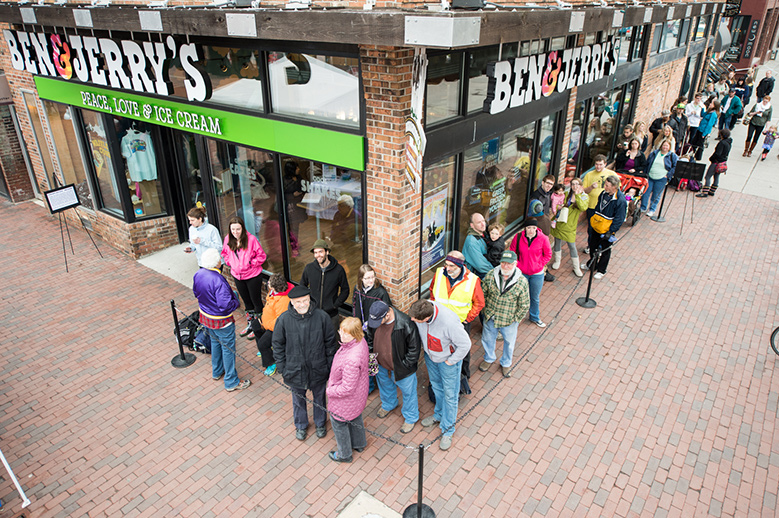They’ll be lined up around the block because the price is too low–just like every day on urban roads
You can learn everything you need to know about transportation economics today, just by helping yourself to a free ice cream cone. One day a year, and today is that day, Ben and Jerry are giving away free ice cream to everyone who comes by their stores. Whether you’re hankering for Cherry Garcia or Chunky monkey, you can now get it for absolutely zero price.
In addition to free ice cream, there also giving a free lesson in why American roads are perpetually clogged, and why state highway departments are (a) always broke, and (b) always think they need to build more and more and more lanes for traffic.
As you’re standing in line waiting for your “free” ice cream cone, give a little thought to the parallels between that line and your typical rush hour traffic jam. In both cases, you’re waiting in line for the same reason–the price is too low, and demand is overwhelming supply. This is the valuable lesson that Ben and Jerry are providing in the fundamentals of transportation economics.

You’ll note that unlike the average day at a Ben and Jerry’s, when you might have to wait in line a for a minute or two to get your favorite flavor, now you’re going to end up waiting twenty minutes, or a half hour, or possibly longer. In terms of customers served and gallons scooped, this is going to be their biggest day of the year–last time they gave out a million scoops of ice cream worldwide.
You’ll probably also notice that most of the people standing in line are people who aren’t working nine-to-five. Not many investment bankers or plumbers, but lots of students, moms with small kids, and people who have at least part of the day off from work. (Unlike waiting in traffic, where everyone is isolated in their cars, and experiencing aggravation and road rage, there’s a kind of social, party atmosphere at Ben and Jerrys.
Make no mistake, although you’re not laying out any cash for your ice cream, you are paying for it: with your time. Let’s say that you’d pay $2.50 for that scoop of Phish Food (they’re a bit smaller than regulation on free cone day). If you have to wait half an hour, and you value your time at say, $15.00 per hour, that $2.50 scoop really cost you something like $7.50. It’s a safe bet that most of the people waiting in line value their time at something less than $5.00 an hour if they’re willing to wait that long for a “free” cone. Also, if you really want ice cream, and are pressed for time, there’s no way that you’re going to jump to the head of the line no matter how much you’d be willing to pay.

Substitute “freeway” for “free cone” and you’ve got a pretty good description of how transportation economics works. When it comes to our road system, every rush hour is like free cone day at Ben and Jerry’s. The customers (drivers) are paying zero for their use of the limited capacity of the road system, and we’re rationing this valuable product based on people’s willingness to tolerate delays (with the result that lot’s of people who don’t attach a particularly high value to their time are slowing down things for everyone).
If Ben and Jerry’s were run by traffic engineers, instead of smart business people (albeit smart business people with a strong social minded streak), they’d look at these long lines and tell Ben & Jerry that they really need to expand their stores. After all, the long lines of people waiting to get ice cream represent “congestion” and “delay,” that can only be solved by building more and bigger ice cream stores. And thanks to what you might call the “fundamental law of ice cream congestion” building more stores might shorten lines a little, but then it would likely prompt other people to stand in line to get free ice cream, or to go through the line twice. But, of course, with zero revenue Ben & Jerry would find it hard to build more stores.
Tomorrow, Ben and Jerry will go back to charging for ice cream. And the lines at their stores will disappear. In another year or two, Manhattan will be doing pretty much the same thing, when it starts charging a price for private vehicles entering Manhattan. Road pricing can get rid of the lines of cars in New York City just as effectively as it does in front of ice cream shops.
No doubt Ben and Jerry generate enough good will, and probably attract a few new customers with their willingness to give up one day of revenue per year. And they’ll make more than enough money on the other 364 days of the year to cover their losses. But what works for ice cream one day a year is an epic failure when it comes to roads. As long as the price is zero, there will be more demand than you can handle, and you’ll be struggling to pay for the capacity that (you think) is needed.
